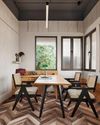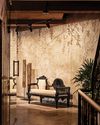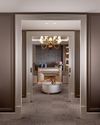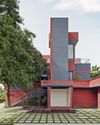
It was thus felt that a set of common guiding principles was becoming necessary to achieve alignment and provide focus to the increasingly diverse group. Thus, a core philosophy evolved with two parts: an over-arching core purpose and a set of core values to guide this purpose.
Sustainability is a phenomenon. It is a concept that stems from and culminates in the way of life. It is about contextual adjustments for the maximum gain, with the least disturbance or imbalance. It is meant to bring appropriateness to the milieu, wherein milieu implies place, people and programme. Architecture too, is a sum total of culture, climate and construction. Sustainable built form thus, refers to a holistic approach to design, and not just environmental management.
Truly sustainable architecture has to go through five fundamental tenets of space making, including: Timeless aesthetics, because buildings last longer than their creators; socio-cultural appropriateness, as spaces are created for the end users; environmental sustainability, since resources are frugal and consumption is high; economic affordability, because only then the resolution would be viable to realise; and structural strength and stability, which will make the built environment last for centuries. The uniqueness of this combination of criteria demands unique solutions over time and space. Therefore, any attempt at converting a phenomenon into a formula—by universalisation of norms and quantification of quality—remains an inherent contradiction to the idea. Phenomenon turned into formula ends up becoming a fashion. And fashion is always appliqué, cursory and temporal.
Bu hikaye Architecture + Design dergisinin November 2019 sayısından alınmıştır.
Start your 7-day Magzter GOLD free trial to access thousands of curated premium stories, and 9,000+ magazines and newspapers.
Already a subscriber ? Giriş Yap
Bu hikaye Architecture + Design dergisinin November 2019 sayısından alınmıştır.
Start your 7-day Magzter GOLD free trial to access thousands of curated premium stories, and 9,000+ magazines and newspapers.
Already a subscriber? Giriş Yap

A GRECIAN RETREAT
Shimona Bhansali imbues a subtle touch of opulence to this home in Mumbai

A BOLD STATEMENT
Dhampur Sugar Mills Limited's workspace in New Delhi designed and built by Officebanao adopts an industrial narrative

A BREATH OF FRAGRANT DESIGN IN DELHI'S HEART
An office that smells like perfumery; that is the vision that TWI brought to life in this office space designed for an acclaimed perfume company in India

MASTER OF ALL TRADES
The ethos of forward-thinking and ingenuity finds its architectural counterpart within the walls of Nikhil Kamath and Abhijeet Pai's office-a vision of organic design infused with the essence of India

A TOUCH OF OPULENCE
Designed by Aparna Kaushik, this Delhi office displays an interesting balance of classic aesthetics and contemporary sensibilities

THE WOODEN WONDERLAND
Priyanka and Piyush Mehra envision a stunning experience centre for Vikas Plywood

THE HUB: BUILDING COMMUNITIES
Studio Lotus designs a dynamic mixed-use community hub that activates Chennai's largest IT Park

THE WINNER'S PERCH
Baldiwala Edge designs a Singapore-based ship broker's office as a torch collector's paradise, offering a 360-degree bird's-eye view of the Mumbai skyline

THE DIRECTOR'S CABIN
Designed by Envisage, this office gives a new definition to the traditional notion of biophilia

Designing Corporate India
From weaving the magic of a Star Trek-themed command centre to crafting bespoke block-printed workstations, Vijaya Bhargav and Arnab Ghosh-the trailblazing co-founders of Ostraca-have astonishingly transformed a staggering 29 million square feet of office space for India's tech giants and global enterprises-all while maintaining a flat hierarchical company culture-fuelling a master class in corporate design